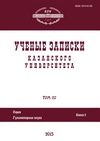СРЕДСТВА ВЫРАЖЕНИЯ СРАВНИТЕЛЬНЫХ ОТНОШЕНИЙ В НАРОДНОЙ ЗАГАДКЕ (НА МАТЕРИАЛЕ РУССКИХ, АНГЛИЙСКИХ, ТАТАРСКИХ ЗАГАДОК)
MEANS OF EXPRESSING COMPARATIVE RELATIONS IN VERNACULAR RIDDLES (BASED ON RUSSIAN, ENGLISH, AND TATAR RIDDLES)
Author(s): Nailya I. FayzullinaSubject(s): Theoretical Linguistics, Semantics, Comparative Linguistics, Eastern Slavic Languages, Philology
Published by: Казанский (Приволжский) федеральный университет
Keywords: paremia; vernacular riddle; denotation; comparison; comparative relations;
Summary/Abstract: The ways of expressing comparative relations in Russian, English, and Tatar vernacular riddles were studied. The study is highly relevant, because the structural and semantic features of these vernacular riddles as of unique language systems and the syntactic relations developed within them have not been described. The research aims to identify and analyze the typical models of comparative relations in the corpus of vernacular riddles. Particular attention was paid to verbalization of the elements in the logical chain of comparison (reference comparison, basis for comparison). Based on the obtained results, a number of conclusions were made. Firstly, the comparative relations in the studied vernacular riddles do not involve verbalization of all the components of the chain of comparison. The standard of comparison was present in most cases, which is directly related to the national mythologies. For the Russian riddles, comparison with a bird (raven, falcon, and swan) is typical, but the basis for comparison may be different. In the English riddles, a wide range of standards was noticed: products, various materials, buildings, and household items. Here, comparison is directly related to the lifestyle of the times when the riddle was created. Secondly, verbalization of the key elements is used to describe a certain feature (color, shape, volume, etc.). Thirdly, in some riddles comparison performs a differentiating function. In this case, the degree of feature manifestation is assessed relative to the “reference” indicators. Such texts may be not image-based and place statistics in the first place. The results of the study are important for further linguo-cognitive analysis of folklore texts.
Journal: Ученые записки Казанского университета. Серия Гуманитарные науки
- Issue Year: 161/2019
- Issue No: 5-6
- Page Range: 58-67
- Page Count: 10
- Language: Russian

